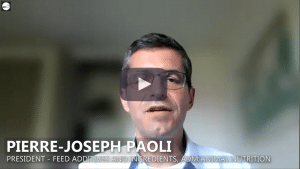Several research groups across the world are researching the challenge of enhancing resilience for heat tolerance in livestock.
Animal science turns to advancing resilience for heat tolerance
Author: Gwendolyn Jones, PhD, Product Manager Gut Agility Activators
Published in: Feed and Additive Magazine, June 2022
Several research groups across the world are researching the challenge of enhancing the resilience of livestock to climatic variability and change. Understanding adaptive mechanisms right down to cellular responses are key to finding technological solutions to advance animal nutrition in its supportive role in optimizing animal performance as the climate is heating up in many countries.
Scientists from leading agricultural universities in the UK, United States, India, Australia and the Netherlands all essentially agree, the adaptation to climate change requires technological advances for climate resilient animals in livestock production. On the other hand, continued selection for greater performance in the absence of consideration for heat tolerance will result in greater susceptibility to negative impacts from rising temperatures for productivity and animal welfare. This is due to the strong relationship between production level and metabolic heat production.
Animal resilience in the context of environmental challenges
Researchers at the University of Armidale claim that for the concept of resilience the animal’s reactions with its environment are central. They describe resilience as the capacity of the animal to return rapidly to its pre-challenge situation. In other words, it is a comparative measure of differences between animals in the impact of a challenge they encounter. Researchers from Wageningen share a similar definition for resilience in farm animals. Thus, resilience relies on the animal’s response or better adaptability to naturally occurring stressors in its environment.
Several disciplines in animal production, including genetics, veterinary sciences and nutrition are currently striving to find ways of positively influencing resilience in farm animals. Better understanding the adaptive processes and finding ways to best measure improvements is integral to enhancing resilience in farm animals.
The role of adaptability
Animals have adaptive mechanisms to cope with rising temperatures, which involve morphological, behavioural and genetic capacity for change. Behavioural changes to rising ambient temperatures are seen in animals, include using shade whenever they have access to it and a reduction in feed intake.
The adaptive processes can further include physiological, neuro-endocrine and cellular responses. Some of the physiological parameters for adaptation to rising temperatures are respiration rate, pulse rate, skin temperature and sweating. However, there are differences between species in the expression of these characteristics. For example, poultry has the characteristics of rich feathers, no sweat glands, strong metabolism and high body temperature. As a result, the production performance of poultry is easily impacted by elevated ambient temperatures.
Research into the physiological changes accompanying high temperatures in tropically adapt- ed species is increasing the understanding of the mechanisms that the animal uses to accomplish the necessary functions effectively, and to find ways to support a more efficient response to minimize the negative impact on performance and animal well- being. Identifying relevant biomarkers in animals capable of maintaining high levels of productivity at high ambient temperatures will also help to breed for climate resilient animals.
Adaptive responses at the cellular level
Exposure to challenges, including environmental ones such as ambient temperatures above thermal comfort zones, induce adaptive responses that al- low cells and organisms to continue normal functions in the face of adverse stimuli. At the cellular level adaptive responses involve multiple changes in gene and protein expression, including induction of cellular defenses, e.g., antioxidants and heat shock proteins to enable the cell to survive.
On the other hand, exposure to challenges will increase cellular levels of reactive oxygen species (ROS). The balance between the generation of ROS and cellular antioxidants determines the level of oxidative stress, which again impacts the animal’s ability to attain performance potential and sustain good health.
A key cellular adaptation mechanism discovered in species surviving extreme environmental conditions is the enhanced expression of the cytoprotective system NRF2-KEAP1, which is involved in protection from oxidative stress, detoxification and protein homoeostasis. The nuclear factor erythroid 2–related factor 2 (NRF2), is part of a complex regulatory network that responds to environmental cues. The subsequent evolution of cysteine-rich Kelch-like ECH-associated protein 1 (KEAP1) provided animals with a more sophisticated way to regulate NRF2 activity. Exposure to oxidants disrupts the interaction between NRF2 and KEAP1, which leads to translocation of NRF2 to the nucleus, which in turn increases the transcription of cytoprotective and antioxidative genes. This also leads to activating antioxidant enzymes, such as superoxide dismutase, glutathione and catalase.
Optimizing NRF2-KEAP activity in farm animals
A better understanding of the biological function, activation and regulation of NRF2-KEAP1 will help find ways of optimizing its activity for increased resilience in farm animals. Insights from in vitro studies carried out on hyperthermia treated bovine mammary epithelial cells demonstrated that the activation of NRF2 leading to upregulation of expression of downstream genes was associated in attenuating heat shock-induced cell damage.
To date it has been established that certain molecules including phytochemicals can activate NRF2. However, scientists also warn of arbitrarily activating the NRF2-KEAP1 pathway and call for more research into optimizing and properly timing interventions to the activity of NRF2. Peer reviewed exploratory research carried out to investigate the effect of a gut agility activator, based on bioactive substances derived from herbs and spices combined with functional carriers, showed that it increased the expression of critical genes of the NRF2-KEAP1 pathway in the gut of broilers. This coincided with increased levels of total antioxidant capacity in breast meat and in organs key to sustaining high productivity (e.g., gut, liver) in broilers. The study also highlighted the importance of evaluating different application levels, as the effects were dependent on inclusion levels.
Conclusion
The above insights suggest that nutritional technological advances involving phytogenic molecules, such as gut agility activators, could potentially play a supportive function in enhancing resilience of poultry. Further research is required under temperatures above the thermal comfort zone and to confirm the positive impact on recognized resilience performance indicators.
Relevant articles
Frequent monitoring reveals poultry resilience indicator
Free Ebook 3 steps to greater resilience in poultry
Animal Resilience – Economic value in livestock production
References
- Mountzouris, K.C., Paraskeuas, V.V., Fegeros, K. (2020). Priming of intestinal cytoprotective genes and antioxidant capacity by dietary phytogenic inclusion in broilers, Animal Nutrition, Vol 6(3), pp. 305-312
- Stenvinkel, , Meyer, C.J., Block, G.A., Chertow, G.M. and Shiels, P.G. (2020). Understanding the role of the cytoprotective transcription factor nuclear factor erythroid 2-related factor 2—lessons from evolution, the animal kingdom and rare progeroid syndromes, Nephrology Dialysis Transplantation, Vol 35 (12), pp. 2036-2045
- Berghof, T.V.L., Poppe, M. and Mulder, H.A. (2019) Opportunities to Improve Resilience in An- imal Breeding Programs, Frontiers in Genetics, Vol 9, pp 692
- Jin, X.L., Wang, K., Liu, L. Liu, H.Y, Zhao, F.Q., Liu, J.X. (2016). Nuclear factor-like factor 2-antiox- idant response element signaling activation by tert-bu- tylhydroquinone attenuates acute heat stress in bovineBerghof, T.V.L., Poppe, M. and Mulder, H.A. (2019) Opportunities to Improve Resilience in An- imal Breeding Programs, Frontiers in Genetics, Vol 9, pp 692



